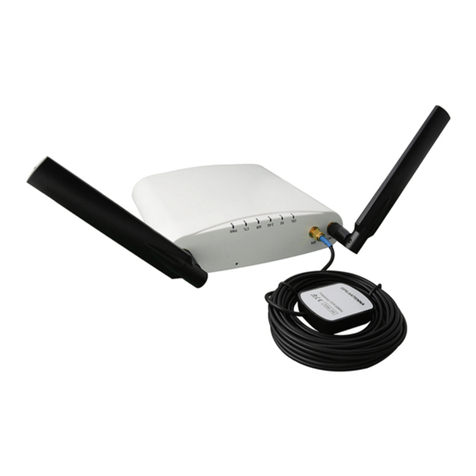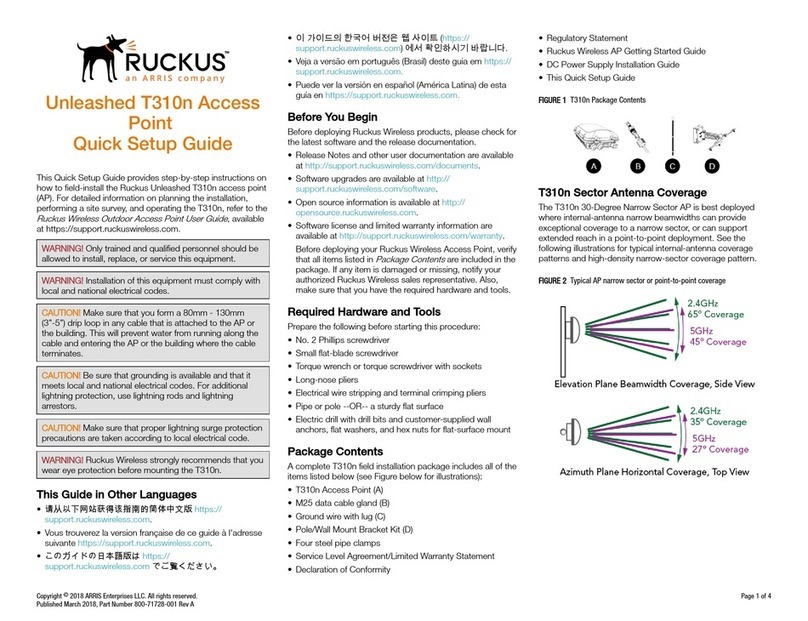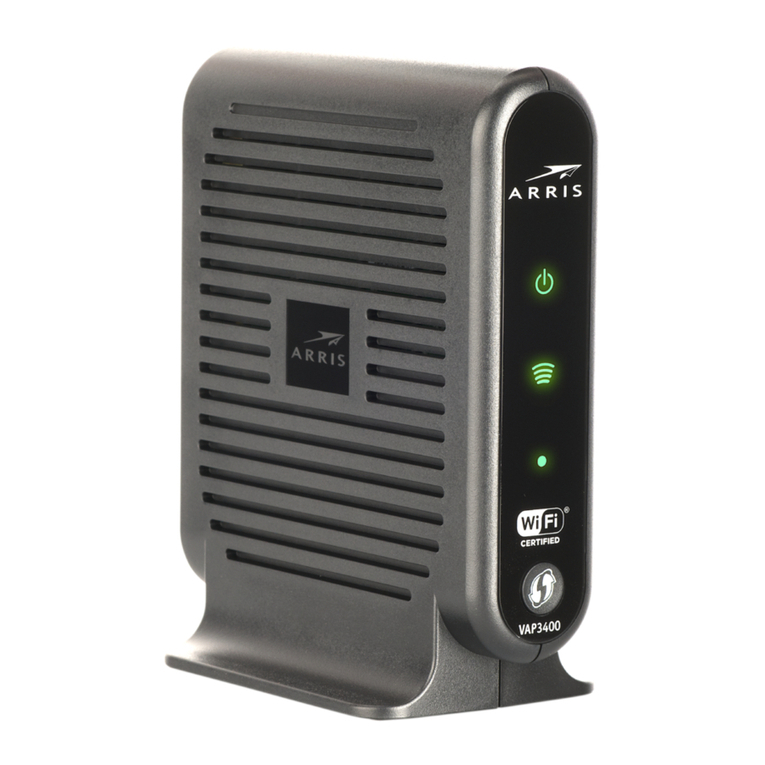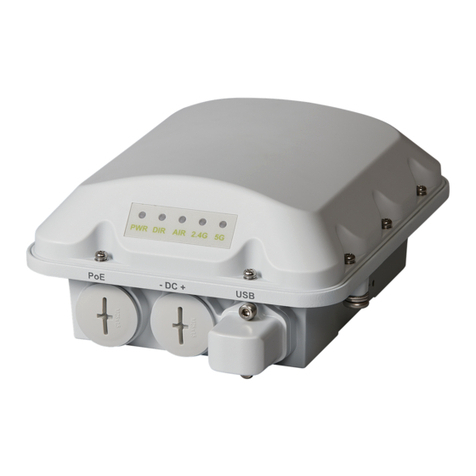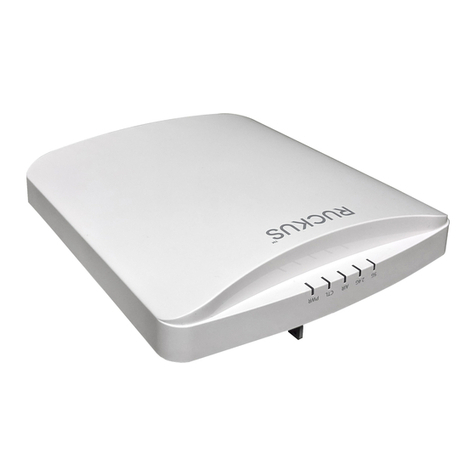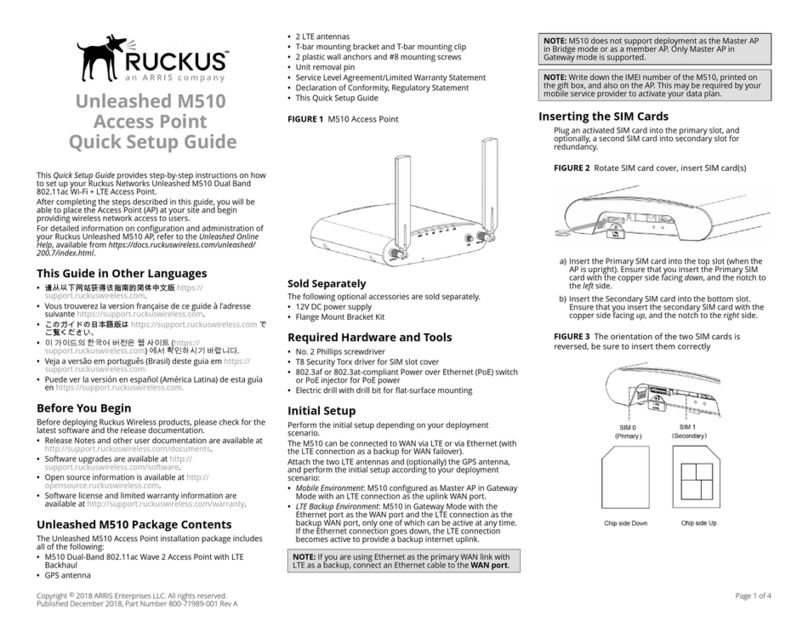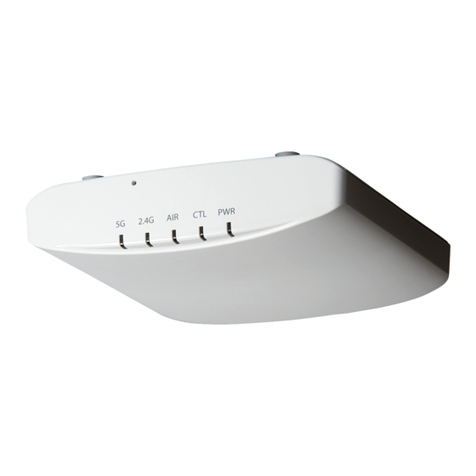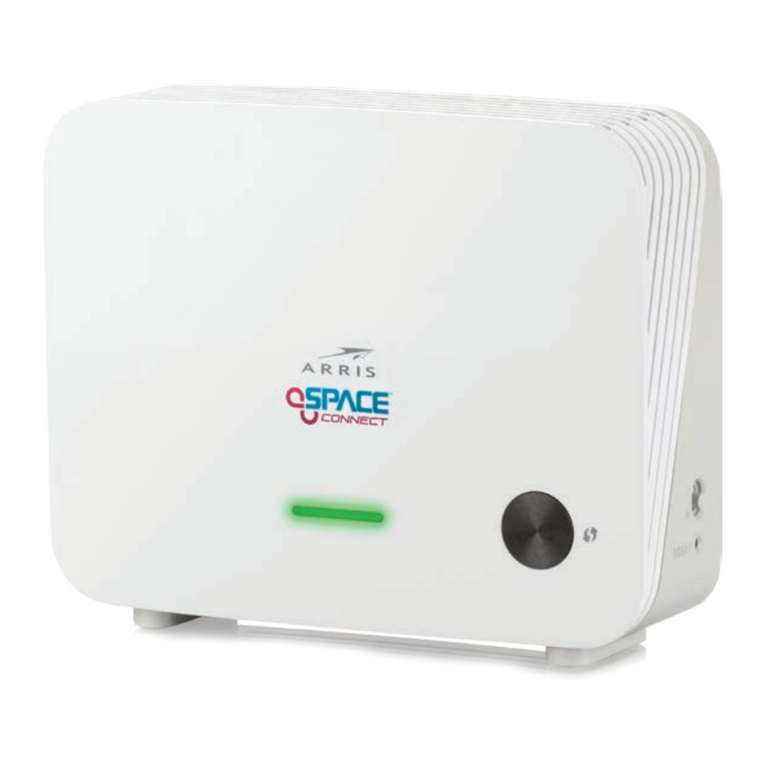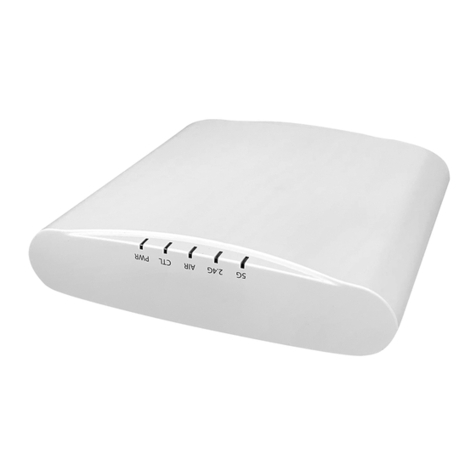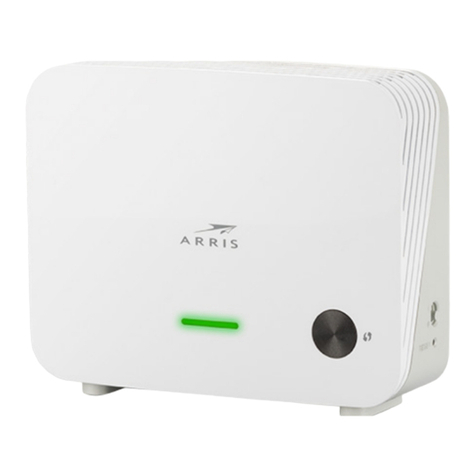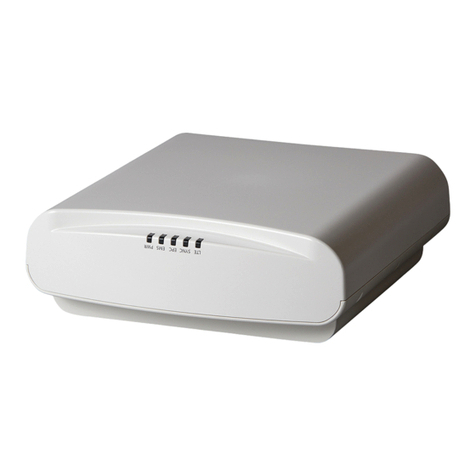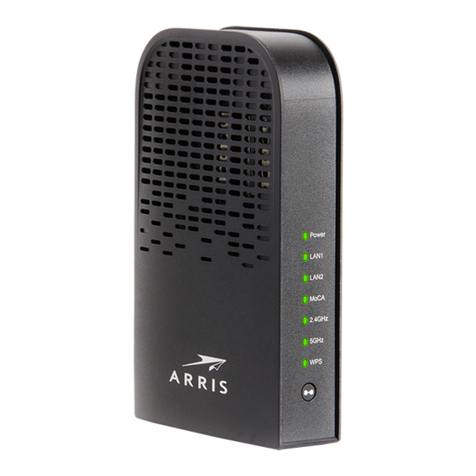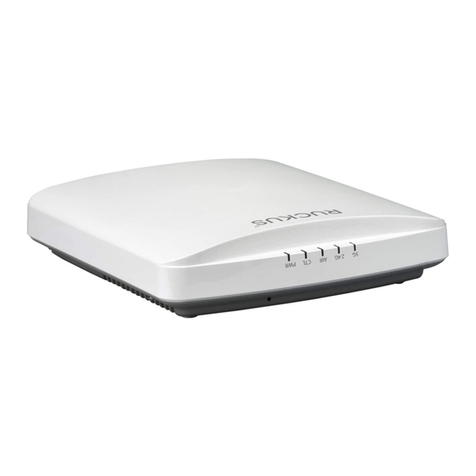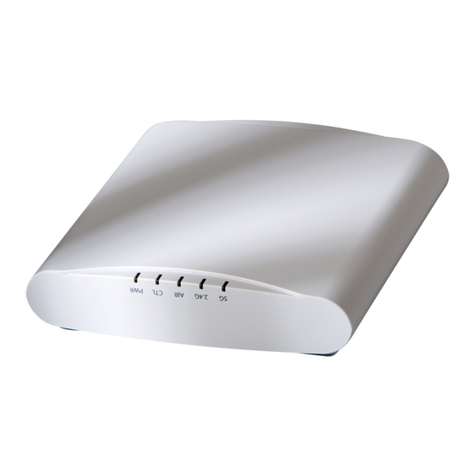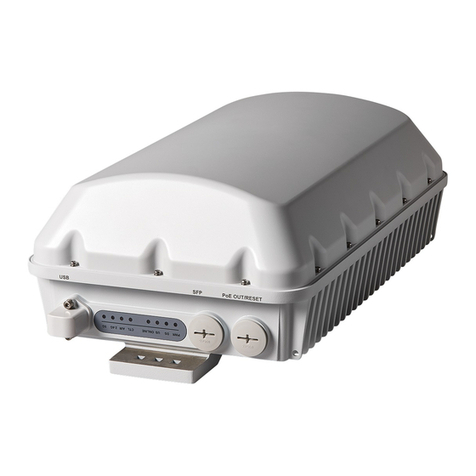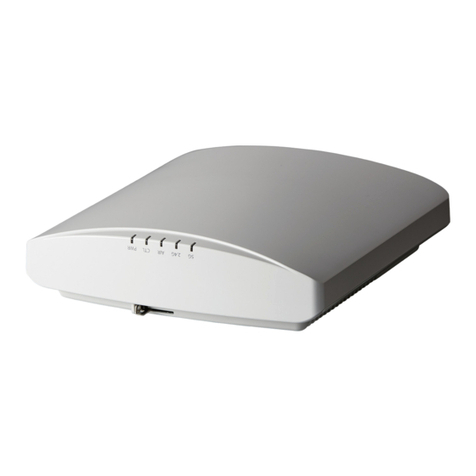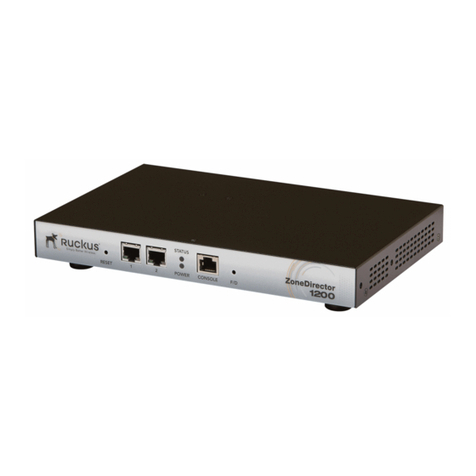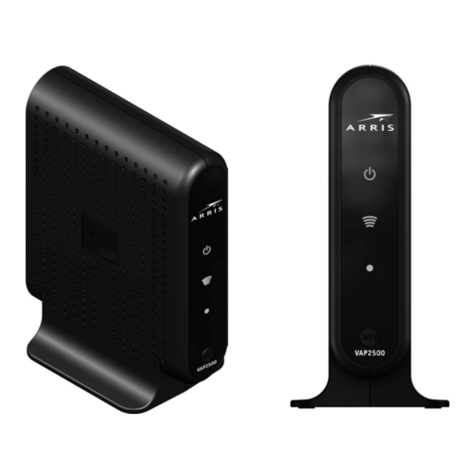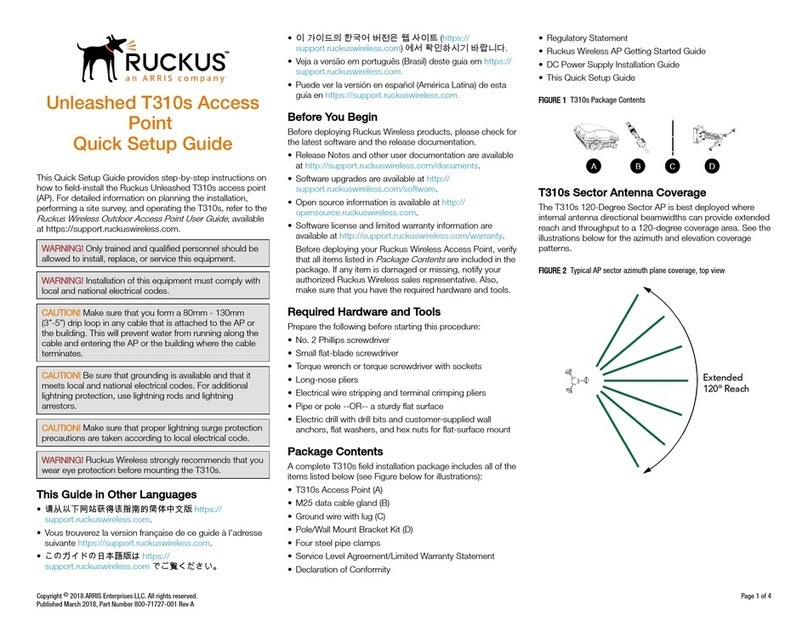
T750 Access Point
Quick Setup Guide
NOTE: The minimum software revision for the T750 Omni is
ZoneDirector (ZD) 10.4 or later, or SmartZone (SZ) 5.2 or later,
or standalone AP rmware 114.X or later.
This Quick Setup Guide provides step-by-step instructions on
how to eld-install the Ruckus Wireless T750 Omni access point
(AP). For detailed information on planning the installation,
performing a site survey, and operating the T750 Omni, refer to
the Ruckus Wireless Outdoor Access Point User Guide, available at
https://support.ruckuswireless.com.
WARNING! Only trained and qualied personnel should be
allowed to install, replace, or service this equipment.
WARNING! Installation of this equipment must comply with
local and national electrical codes.
CAUTION! Make sure that you form a 80mm - 130mm (3”-5”)
drip loop in any cable that is attached to the AP or the
building. This will prevent water from running along the cable
and entering the AP or the building where the cable
terminates.
CAUTION! Be sure that grounding is available and that it
meets local and national electrical codes. For additional
lightning protection, use lightning rods and lightning arrestors.
CAUTION! Make sure that proper lightning surge protection
precautions are taken according to local electrical code.
WARNING! Ruckus Wireless strongly recommends that you
wear eye protection before mounting the T750 Omni.
This Guide in Other Languages
•请从以下网站获得该指南的简体中文版 https://
support.ruckuswireless.com.
•Vous trouverez la version française de ce guide à l'adresse
suivante https://support.ruckuswireless.com.
•このガイドの日本語版は https://support.ruckuswireless.com で
ご覧ください。
•이 가이드의 한국어 버전은 웹 사이트 (https://
support.ruckuswireless.com) 에서 확인하시기 바랍니다.
•Veja a versão em português (Brasil) deste guia em https://
support.ruckuswireless.com.
•Puede ver la versión en español (América Latina) de esta guía
en https://support.ruckuswireless.com.
Before You Begin
Before deploying Ruckus Wireless products, please check for the
latest software and the release documentation.
•Release Notes and other user documentation are available at
http://support.ruckuswireless.com/documents.
•Software upgrades are available at http://
support.ruckuswireless.com/software.
•Open source information is available at http://
opensource.ruckuswireless.com.
•Software license and limited warranty information are
available at http://support.ruckuswireless.com/warranty.
Before deploying your Ruckus Wireless Access Point, verify that
all items listed in Package Contents are included in the package.
If any item is damaged or missing, notify your authorized
Ruckus Wireless sales representative. Also, make sure that you
have the required hardware and tools.
Required Hardware and Tools
•1/2” (13 mm) at-blade screwdriver or equivalent
•No. 2 Phillips screwdriver
•Small at-blade screwdriver
•Torque wrench or torque screwdriver with sockets
•Long-nose pliers
•Electrical wire stripping and terminal crimping pliers
•Pipe, pole or a sturdy at surface
•Electric drill with drill bits and customer-supplied wall anchors,
at washers, and hex nuts for at-surface mount
Package Contents
A complete T750 eld installation package includes all of the
items listed below :
•T750 Access Point
•M25 data cable gland extender
•Three M25 data cable glands
•Outdoor AP Mounting Bracket kit
•One ground wire with lug
•Cloud Management Statement
•Cable gland extender gasket
•AC Connector
•Zipcord cable gland grommet
•Four 1/2” (12.7 mm) wide adjustable clamps, 2.5” (63.5 mm)
diameter, for main mounting bracket on smaller poles
•Safety cable kit
•Service Level Agreement/Limited Warranty Statement
•Declaration of Conformity
•Regulatory Statement
•Ruckus Wireless AP Getting Started Guide
•This Quick Setup Guide
Mounting Instructions
Connecting and Sealing the RJ-45 Cables
The T750 may use zero, or one or two RJ-45 cables, one for
Ethernet when congured as a Root AP (RAP), and another when
the T750 is supplying PoE out to a peripheral device, such as a
small cell or micro cell radio. When the T750 uses RJ-45 cables,
connect and seal the cables using the M25 data cable glands as
shown in Figure 2.
FIGURE 1 T750 AP PoE IN and PoE OUT ports
1. SFP port
2. PoE IN
3. PoE OUT
4. AC port
WARNING! Do not use any PoE injector not tested and
approved by Ruckus Wireless to power the T750 Access Point.
WARNING! Do not plug PoE IN power into the PoE OUT port.
See Figure 1.
1. Feed the end of the cable through the gland dome, rubber
grommet, clamping ring assembly and cable gland base, as
shown in Figure 2.
NOTE: Do not seat the clamping ring and rubber grommet
into the cable gland base until the cable gland base has
been torqued to specications.
FIGURE 2 RJ-45 Cable and Cable Gland Assembly
1. SFP Port
2. Clamping ring
3. Rubber grommet
4. Gland dome
2. Use a wide at-blade screwdriver to remove the required
(PoE OUT or PoE IN) blanking cap from the T750.
3. Connect the cable to the Ethernet port in the AP.
4. Tighten the cable gland base to 7 N.m (62 in-lbs).
5. Wrap the clamping ring assembly around the rubber
grommet. Make sure that the clamping ring assembly fully
encloses the rubber grommet.
Copyright © 2019 CommScope, Inc. All rights reserved. Page 1 of 4
Published December 2019, Part Number 800-72101-001 Rev C
